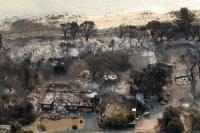-
Post-earthquake losses: Devastating and costly
Since 1900, 2.3 million people have died in 2,233 earthquakes, yet it is important to understand that 93 percent of the fatalities that occurred as a result of violent earthquakes happened in only 1 percent of key earthquakes. In other words, the worst devastation tends to happen in only a very few quakes and generally as a result of dire secondary effects. A new study recommends we shift our focus to learn from and prepare against the range of disasters that typically follow — and for which we are often unprepared.
-
-
Enabling communities to be disaster-proof
S&T says that one of its “visionary goals” is to enable communities to be disaster-proof. S&T cannot eliminate disasters, but it can arm decision makers with tools and plans that will ultimately shield communities from negative consequences. A critical step towards building disaster-proof communities is being able to ask and receive help from a neighbor. Though most disasters begin and end locally, large-scale and catastrophic disasters require coordinated mutual aid from a broad range of partners across geographic boundaries.
-
-
Biomedical research community should build resilience to disasters
The academic biomedical research community should improve its ability to mitigate and recover from the impacts of disasters, says a new report from the National Academies of Sciences. The consequences of recent disasters, from hurricanes to cyberattacks, have shown that the investments of the U.S. federal government and other research sponsors — which total about $27 billion annually — are not uniformly secure. “Continuing scientific advancement and the promise of future discoveries will require a commitment to resilience — and an unparalleled partnership across the emergency management and academic research sectors,” says one of the report’s authors.
-
-
Resilience study helps governments prevent disaster-related loss
Hurricanes, wildfires, tsunamis and other disasters cannot be stopped, but countries can plan for them — something some areas of the world seem to do better than others, according to a new study. The researchers derived 38 factors that affect a country’s resilience, using national and international databases which included the U.S. Census, the United Nations and the World Health Organization. The researchers used these databases to grade the resilience of each country and continent and develop a comprehensive index that includes indicators such as the number of disasters and their death tolls, as well as an area’s population, infrastructure, economy and educational system.
-
-
New data set explores 90 years of natural disasters in the U.S.
Every year, major earthquakes, floods and hurricanes occur. These natural disasters disrupt daily life and, in the worst cases, cause devastation. Events such as Hurricanes Katrina and Sandy killed thousands of people and generated billions of dollars in losses. There is also concern that global climate change will increase the frequency and intensity of weather–related disasters. We have created a new database that covers disasters in the United States from 1920 to 2010 at the county level. Our work shows that people move away from areas hit by the largest natural disasters, but smaller disasters have little effect on migration. The data also showed that these trends may worsen inequality in the United States, as the rich move away from disaster-prone areas, while the poor are left behind.
-
-
Citizen science to aid in disaster response
After natural disasters, communities need fast access to damage assessment maps to aid relief, recovery and rebuilding efforts. Researchers have developed a new way to link volunteers around the world with a way to help communities after major disasters, aiming to aid disaster damage mapping, providing much-needed real-time data to help communities recover and rebuild after disaster. For the next few weeks they are testing the new system – inviting the public to take part.
-
-
New resilience study helps governments prevent disaster-related loss
Hurricanes, wildfires, tsunamis, and other disasters cannot be stopped, but countries can plan for them — something some areas of the world seem to do better than others, according to a new study. In the study, thirty-eight factors that affect a country’s resilience were derived from national and international databases, and the researchers used these databases to grade the resilience of each country and continent and develop a comprehensive index that includes indicators such as the number of disasters and their death tolls, as well as an area’s population, infrastructure, economy and educational system.
-
-
How disaster relief efforts could be improved with game theory
The number of disasters has doubled globally since the 1980s, with the damage and losses estimated at an average $100 billion a year since the new millennium, and the number of people affected also growing. Hurricane Katrina in 2005 was the costliest natural disaster in the U.S., with estimates between $100 billion and $125 billion. The death toll of Katrina is still being debated, but we know that at least 2,000 were killed, and thousands were left homeless. Worldwide, the toll is staggering. The challenges to disaster relief organizations, including nongovernmental organizations (NGOs), are immense, and the competition among them is intense. My team and I have been looking at a novel way to improve how we respond to natural disasters. One solution might be game theory.
-
-
Recovery lessons from Hurricane Sandy to help improve resilience, disaster preparedness

Purdue University will lead a $2.5 million, four-year research to determine why some communities recover from natural disasters more quickly than others, an effort aimed at addressing the nation’s critical need for more resilient infrastructure and to enhance preparedness. The research team will apply advanced simulations and game-theory algorithms, access millions of social media posts and survey data collected along the New Jersey shore, which was devastated by Hurricane Sandy in 2012.
-
-
Recovering from disasters: Social networks matter more than bottled water and batteries

Almost six years ago, on Friday, March 11, 2011, Japan faced a paralyzing triple disaster: a massive earthquake, tsunami, and nuclear meltdowns that forced 470,000 people to evacuate from more than 80 towns, villages and cities. My colleagues and I investigated how communities in the hardest-hit areas reacted to these shocks, and found that social networks - the horizontal and vertical ties that connect us to others - are our most important defense against disasters. As communities around the world face disasters more and more frequently, I hope that my research on Japan after 3/11 can provide guidance to residents facing challenges. While physical infrastructure is important for mitigating disaster, communities should also invest time and effort in building social ties.
-
-
Disaster Survival Skills launches new disaster preparedness calculator
Seismologists have warned for years about the danger of a so-called “megaquake” devastating the Pacific Northwest upon the rupture of the region’s Cascadian Subduction Zone. Disaster Survival Skills launched its brand-new online Family disaster preparedness calculator. After in-putting a few simple pieces of information, Disaster Survival Skills site visitors will receive a customized list of disaster supplies and advice that can be used to prepare for earthquakes, floods, and other emergencies.
-
-
Be Prepared: Canada engages youth in disaster resilience
Large-scale natural disasters have been on the rise worldwide, and while the exact cause is unclear, there is something most scientists, policy-makers, and legislators can all agree with — the increasing global need to invest in disaster preparedness, prevention, and recovery. Canadian experts say they are constantly evaluating and improving Canada’s emergency preparedness and the most effective ways to keep people safe. But some experts are taking a different approach to disaster resiliency: they are engaging youth.
-
-
Improving infrastructure resilience to withstand natural disasters
Over the past decade, some 80 000 people have died in Europe as a result of natural disasters. EU-funded researchers have created a tool to assess the impact of natural disasters on transport infrastructure in order to save both lives and money. The tool, developed through the EU-funded INFRARISK initiative, aims to help policy makers and industry experts identify ways of improving the resilience of bridges, roads, and rail networks in the face of catastrophic events such as earthquakes, floods, and landslides.
-
-
Growing number of Hurricane Sandy-like storm surges in future
In the wake of historic destruction wrought by Hurricane Sandy in 2012, residents of New York and other coastal cities were left wondering whether Sandy-scale storm floods are the new normal. Now, researchers have developed a computer simulation that estimates that storm-related flooding on the New York City coastline similar in scale to those seen during Sandy are likely to become more common in coming decades. The worst-case scenario has the frequency increasing by seventeen times by the year 2100.
-
-
New $4 million facility at UW to investigate natural disasters worldwide
A new Post-Disaster, Rapid Response Research Facility at the University of Washington will provide necessary instrumentation and tools to collect and assess critical post-disaster data, with the goal of reducing physical damage and socio-economic losses from future events. The NSF’s $40 million NHERI investment, announced in September 2015, funds a network of shared research centers and resources at various universities across the nation. The goal is to reduce the vulnerability of buildings, tunnels, waterways, communication networks, energy systems, and social groups in order to increase the disaster resilience of communities across the United States.
-
- All
- Regional
- Water
- Biometrics
- Borders/Immig
- Business
- Cybersecurity
- Detection
- Disasters
- Government
- Infrastructure
- International
- Public health
- Public Safety
- Communication interoperabillity
- Emergency services
- Emergency medical services
- Fire
- First response
- IEDs
- Law Enforcement
- Law Enforcement Technology
- Military technology
- Nonlethal weapons
- Nuclear weapons
- Personal protection equipment
- Police
- Notification /alert systems
- Situational awareness
- Weapons systems
- Sci-Tech
- Sector Reports
- Surveillance
- Transportation
Advertising & Marketing: advertise@newswirepubs.com
Editorial: editor@newswirepubs.com
General: info@newswirepubs.com
2010-2011 © News Wire Publications, LLC News Wire Publications, LLC
220 Old Country Road | Suite 200 | Mineola | New York | 11501
Permissions and Policies
Editorial: editor@newswirepubs.com
General: info@newswirepubs.com
2010-2011 © News Wire Publications, LLC News Wire Publications, LLC
220 Old Country Road | Suite 200 | Mineola | New York | 11501
Permissions and Policies
